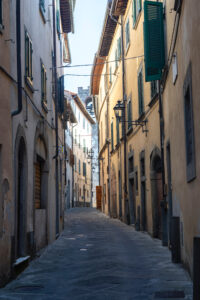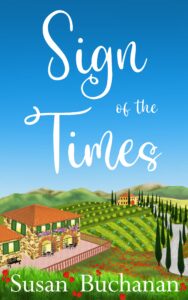 Travel is a major passion of mine, but without question, Bibbiena in north-east Tuscany is my favourite real setting in my books. The hilltop town set in the Casentino Valley is surrounded by lush greenery and vineyards. I have a natural love of Italy and all things Italian – I studied Italian at university and Bibbiena was the setting that inspired me to write my first book, Sign of the Times, which celebrated its tenth anniversary in March. I’d never been to this corner of Tuscany and it was one of those random lucky finds, but it will stay with me forever.
Travel is a major passion of mine, but without question, Bibbiena in north-east Tuscany is my favourite real setting in my books. The hilltop town set in the Casentino Valley is surrounded by lush greenery and vineyards. I have a natural love of Italy and all things Italian – I studied Italian at university and Bibbiena was the setting that inspired me to write my first book, Sign of the Times, which celebrated its tenth anniversary in March. I’d never been to this corner of Tuscany and it was one of those random lucky finds, but it will stay with me forever.
Probably the best way to do it justice is via an excerpt:
‘Holly’s thoughts returned to Dario as she padded down the windy road and up the hill to the centre of Bibbiena. It was a little as she had expected: bumblebee-striped canopies and green chairs stacked on top of tables, at what she could only assume was one of the restaurants on closing day. A group of teenagers stood around chatting and flirting. Holly strolled past them and spied twenty or thirty stalls with canvas awnings ahead of her. So, there is a market. Continuing, she passed a bar on the opposite side of the road, where four elderly men were playing chess. Holly watched them for a few minutes and then, conscious they had stopped chattering and were looking in her direction, waved then moved on.
 She crossed the road a little further along and turned up into the village centre, following the sign for the church. The reddish-brown buildings were of rough-hewn stone and Holly guessed they were eighteenth century. Today she wanted to absorb the atmosphere, without having to remember she had to write about it. She passed a tabacchi, a lawyer’s office, an accountant’s, until finally she came across a bottega. As she peered through the glass in the door, the owner sprang to open it, and she fell forward into the shop, almost colliding with him.
She crossed the road a little further along and turned up into the village centre, following the sign for the church. The reddish-brown buildings were of rough-hewn stone and Holly guessed they were eighteenth century. Today she wanted to absorb the atmosphere, without having to remember she had to write about it. She passed a tabacchi, a lawyer’s office, an accountant’s, until finally she came across a bottega. As she peered through the glass in the door, the owner sprang to open it, and she fell forward into the shop, almost colliding with him.
‘Scusi, signorina.’
Holly waved away his concern and then picked up jars and bottles, examining the contents and ingredients. The bottega was filled with mouth-watering goodies; pickled vegetables, zucchini, red peppers and cherry tomatoes filled with anchovies. The upper part of one wall consisted only of wine and the lower half entirely of olive oil. Holly had never seen so many different kinds of olive oil. Next to the cassa and the beaming shop owner lay a wide assortment of cold meats and cheeses. Holly wanted to buy up the whole shop. Then she clapped eyes on the counter of fresh pasta…mmm. Ricotta-filled ravioli, pumpkin stracci…’
 Holly’s subsequent conversation with the shop owner, Giampiero, reveals much about small-town and village life, not least the warmth and friendliness of the people. He knows where she is staying, and when she tells him her landlady has invited her for dinner, he calls the butcher to ask if Viviana, the landlady, has been in, and if so, what she ordered. He gives Holly the story behind the prize-winning bottles of olive oil and once he knows what they’re having for dinner, he helps Holly pick out the perfect wine.
Holly’s subsequent conversation with the shop owner, Giampiero, reveals much about small-town and village life, not least the warmth and friendliness of the people. He knows where she is staying, and when she tells him her landlady has invited her for dinner, he calls the butcher to ask if Viviana, the landlady, has been in, and if so, what she ordered. He gives Holly the story behind the prize-winning bottles of olive oil and once he knows what they’re having for dinner, he helps Holly pick out the perfect wine.
The villa on the cover is a representation of the one I stayed at, and the house in the distance, one I could see from my villa, and the location of a wedding in the novel.
After a ten-year break from writing about Bibbiena, I can’t wait to return to it in 2023. If you haven’t been to this gorgeous corner of Tuscany, please do. You won’t be disappointed.
